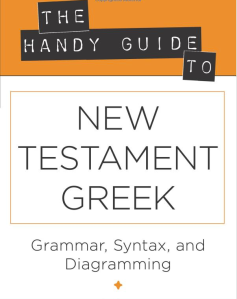This is a book review of The Handy Guide to New Testament Greek:
Grammar, Syntax, and Diagramming by Douglas S. Huffmann. Thanks to Kregel Academic for providing a complimentary copy of the book in exchange for an unbiased review.

I have often commented that a pastor/teacher can teach anything with a timeline, a map, an outline, and a chart/table. This book fits conveniently in the last two categories. It is filled with tables that make quick reference easy and readable. It is a book every post-first year Greek student and pastor should have “handy.”
Physical characteristics:
The physical dimensions match exactly the NA-27/28 editions as well as the UBS-4th edition. Thus, it can be easily stored and taken alongside the Greek New Testament for easy reference. This makes a convenient aid for pastors who want to maintain some fluency with NT Greek as well as seminary students.
The font and color combinations make for a readable book. The only possible change I could suggest refer to change the light color of the headings to be darker, specifically on pp. 54-58. The font is already different than the text font, and so the faint orange color of the headings are less than ideal. This is more problematic in low light situations and for those who have partial color blindness.
Part 1 Grammar:
The first 54 pages are tables of various forms for parts of grammar (nouns, adjectives, verbs, etc.). These are generally very concise summaries and good for review. The tables are clear, and cover what is necessary in a review of this kind.
When discussing prepositions, he includes only one table (p. 23), and that in reference only as prefixes for verbs. I think another table of common prepositions with multiple cases would have been helpful for review. Thus, the differences in meaning of δια with either genitive (“through” used of instrument, space, time, i.e. John 4:4) or accusative (“on account of” i.e., Matt. 24:9) and other prepositions could be summarized—an important aid for the students. In my experience, the confusion on preposition usage and translation continues even after the first year.
Part 2 Syntax:
The case reviews for nouns were comprehensive while still being concise. I liked the fact that he included at least one NT reference for each part of the discussion. Also, the genitive case tends to be the most flexible and least understood of the noun forms. He provides 20 different elements for better understanding the function and meaning of the genitive. Well done!
The section on verbs is thorough as well. The Introduction on pp. 61-63 is the best Tense introduction to verbs I have seen; good aid for students. The table on p. 62 concerning the three aspects (progressive, summary, stative) of verb usage is almost worth the price of the book itself as a teaching aid. I like the explanations of imperfect and aorist tense (pp. 64-65).
For Mood, the descriptions and examples continue to make this valuable. The discussion of Subjunctives, pp. 70-71, provides an excellent resource. The table on p. 69 is likewise crucial for review. The Participle presentation, pp. 75-79 is very helpful. The chart, Participle Usage Identification Guide, p. 80 , is excellent. It is the first time I have seen something that comprehensive put into one concise page.
Part 3: Diagramming
The diagramming of sentences in Greek is probably the least understood and used by first year students. I think that is because many have never had to diagram English sentences. Thus, the concept itself is almost foreign to our seminary students. Thankfully, this is the most detail oriented section of the entire book.
Huffmann has provided a valuable tool to accomplish the diagramming of Greek phrases/sentences. Not only does he describe the process, he shows completed examples, as a motivation for the student to continue to use this process in Bible study and sermon preparation.
Summary:
Douglas Huffmann offers a valuable tool for progressing students of Koine Greek. I have taught Greek several times over the past three decades and this would have been an important contribution toward the end of the first year. For continuing students of Greek and for pastors wishing to brush up and review Greek, this tool will be well worth your time and money.
Hmmmm – looks interesting- wonder when it is available on logos…
🙂
What’s a book btw?
LikeLike
Book: something you young kids need to learn about. It is a portable device that allows reading, and marking with any kind of writing utensil (apart from the computer!). Try it, you’ll never go back. LOL
LikeLike
So would this be a useful tool for my second year Greek students? They generally have wrapped up or almost wrapped up Machen and still have the book with all its paradigms handy. We usually use the Kubo reader’s lexicon, which I find to have some very handy though unintuitive paradigm charts as well as brief summaries of grammar.
LikeLike
Howdy, Dave,
I had taught myself using Machen’s book. And I have Kubo’s lexicon. This book functions differently than either of those books. Machen is laid out for extended learning, whereas this book draws everything together with out the exercises, etc. Kubo is meant for reading through a chapter/book with minimal looking up of words in a more formal lexicon (i.e. BDAG). This book does not give definitions at all.
The advantage of this book is that the explanations are next to the tables, and for the Syntax, the parts are all together, so that you can see the various connections but especially distinctions among various parallel constructions. For the purposes of review of Greek, this book is better. Additionally, it draws upon the recent Greek studies and syntactical literature (Machen is 70 years out of date; Kubo is 37 years out of date).
LikeLike